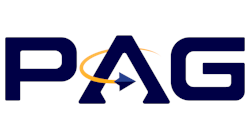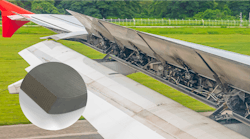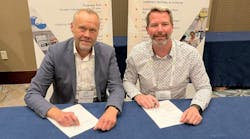Taking Flight with an NDT Level III—Aircraft Inspection Using Eddy Current Testing
With more than 40 years’ experience in the aviation industry, NDT Level III Edward P. Dukich is an expert on aircraft inspection and training, most notably spotting flaws in aircraft. In this article, Ed shares the story of his journey as an NDT Level III specialized in aviation, guidance on eddy current flaw inspection and detectors.
Taking Flight in a Career as an NDT Level III
An American Society for Nondestructive Testing (ASNT) and NAS-410 NDT Level III, Dukich began his aviation career after enlisting in the US Air Force in early 1974, toward the end of the Vietnam War, as an aircraft mechanic on a KC-135A tanker aircraft. He later worked as a final inspector in at the Grumman Aerospace factory. By 1990, Dukich had shifted to work in corporate aviation at Garrett Aviation in Long Island, New York.
Following an economic downturn, he went to Lockheed Commercial Aircraft where he did NDT inspections on Boeing 747 C and D checks and Section 41 modifications. He then went to Saudi Aramco Oil Company. After a year with Tower Air inspecting 747s, he returned started his own consulting firm on Long Island in 1995: NDT Level III Resources. The firm provides services of inspections, auditing, training and certification testing.
Specializing in the aviation industry and assisting aviation companies in manufacturing, overhaul and in-service operation, Dukich performs an extensive amount of eddy current inspections on aircraft, the vast majority of which involve localized damage evaluation. Ed has logged more than 700 hours of technical training.
Conducting Eddy Current Inspections for Aircraft
Aircraft on the frontline is typically maintained after a set number of flying hours or landings to ensure pilot safety, mission success and to keep the aircraft in the air.
A typical heavy inspection is broken up into phases and can involve:
- Removing hundreds of aircraft panels, flight controls and components
- Changing out numerous parts
- Fixing critical items and findings
- Performing quality assurance
- A post engine run
A phase dock inspection team works in split shifts to keep inspections going 24/7. Each inspection is largely in-depth, yet different each time based on an aircraft’s systems and maintenance issues. This keeps inspection team members learning a lot about an aircraft over time.
Aviation inspectors must be familiar with multiple nondestructive technologies. Nondestructive testing (NDT) is an essential part of any ongoing maintenance program for aging aircraft. NDT is a cost-effective way to check aircraft components and structures for defects without having to remove components from the aircraft. These defects include stress cracking, fatigue cracking, corrosion, disbonds and delaminations.
Eddy current testing, also known as ECT, is an NDT method based on the principle of electromagnetic induction used to detect and characterize flaws in conductive materials. High-frequency ECT (HFEC) is sensitive to small cracks and can quickly detect surface and near-surface defects.
Aircraft are constructed using thousands of bolts and fasteners. The fastener holes are a critical zone for structural integrity testing, as the metal around these bolts is susceptible to stress cracking. Consequently, aircraft manufacturers routinely recommend crack detection using ECT. HFEC is used for surface crack detection as well as aluminum conductivity measurements for the detection of heat treat and hardness conditions, such as overheating and fire damage.
For incoming inspections, this technique is used to correctly identify original materials ordered and to sort materials. Aviation also extensively incorporates the use of low-frequency eddy current (LFEC) testing to detect second- and third-layer subsurface cracking, detect opposite wall corrosion and make material thickness measurements.
Dukich's initial introduction to ECT came about while working as a structural inspector with Grumman. His initial training came into play when he was presented with a situation where a US Navy E-2C aircraft model had added near to 40,000 lb. (~18 tons) of weight in electronics but did not reinforce the airframe. Structural cracks were appearing in the center wing sections of the aircraft due to the additional payload. As a result, there was a need for eddy current inspection to be done on the aircraft’s fastener holes.
Throughout his years in the aviation industry, Dukich has worked on various aircraft models.
All aircraft manufacturers, either civilian or military, are required to have an NDT inspection program (NDI) for each manufactured aircraft and must follow service checks based on manufacturers’ knowledge of the aircraft structure performances. NDI program documents offer direction on what NDT method to use and the equipment requirements (instruments, probes, transducers and supporting reference standards). The aircraft operators or maintenance shops follow the procedures to inspect components or structures listed in the NDI program.
ECT has many benefits. An eddy current probe, paired with an eddy current flaw detector, can provide aircraft manufacturers with an economical and effective method to inspect critical aircraft components before they go back into service. In many cases, the paint or coatings (up to a certain thickness), don’t have to be removed before inspection; this amounts to a huge time savings.
Versatile and easy-to-use eddy current flaw detectors such as the NORTEC 600 instrument are on the market today that help inspectors complete the job thoroughly and efficiently. The goal is to ensure that the aircraft can safely continue to operate and is not grounded unnecessarily.
According to Dukich, indispensable features in an eddy current flaw detector include:
· User-friendliness – so others can jump in quickly to help is essential, according to Dukich. “I like to know that I could get somebody up and running on it in an hour.”
· Complete authority adjustments for both the vertical and horizontal gain controls.
· Full authority low-pass and high-pass filter adjustments.
· Portability – Dukich recommends selecting an eddy current instrument that’s light (Nortec 600 weighs about 1.7 kg or 3.75 lb.), easy to transport and therefore more economical, for the aircraft industry.
Aircraft manufacturers’ in-service NDT procedures often include the most economical NDT methods, mostly because they don’t want their aircraft to be put out of service. When this happens, specialized personnel and/or a larger system is required to be flown in, or the aircraft must be moved to inspect it.
“Cost is a major concern with business aircraft, particularly the charter services, which there are a lot of right now,” he explained.
With the decrease in commercial airline flights – which to the surprise of many also carry a great deal of freight – companies are chartering airplanes so they can move additional cargo and transport parts to their manufacturing facilities to keep production going.
Amazon recently purchased several Boeing 767-300 aircraft for this very reason, and to meet growing customer demand and delivery needs.
Hiring and Outsourcing an NDT Level III for Aircraft Inspection and Skills Training
As a Level III consultant, Dukich has been hired and outsourced to work with several companies to serve their inspection, auditing and training purposes.
He trains on all three Levels and when he is outsourced as the Level III for a company, he takes on the responsibility of inspecting documentation and certifying whether the aircraft is airworthy and can be put back in service.
“These companies are paying for the [aircraft maintenance] knowledge,” he said. “As a Level III, you’re getting paid to be right. You cannot get involved as a Level III in NDT and skirt quality assurance issues.”
As an NDT Level III inspector, he is often called out to a job with no real guidelines. When an aircraft manufacturer has a nondestructive requirement for one of its aircraft, it turns to the engineering team to develop an inspection procedure. Dukich often works with engineering to help them determine the best inspection method. He does impromptu damage type inspections and timed inspections.
“Just when you thought you’ve seen it all, you see something different, and so every job is a learning experience,” said Dukich. “Ninety-five percent of airplanes are still metal. However, with the newer ones that have come out in the last 10 to 15 years, everything is getting thinner and lighter. Materials of different alloys, aluminum lithium, mixed use and magnesium (as found in helicopter transmission housings, for example), composites – you need to know what you are looking at.”
Knowledge of material fabrication and finishing processes as well as fit, form and function are important factors to be considered to perform an accurate appraisal of what might be found.
“Things are getting lighter and thinner due to the fuel burn economy and so NDT is becoming even more necessary. On metal-aluminum aircraft, even just surface scratches on the aircraft’s skin can cause alarm. Metals expand and contract with severe temperature changes and could be coupled with environmental conditions such as vibrations and pressurization.”
For inspections, Dukich must do what the NDI aircraft maintenance manual says but carries the equipment needed to perform additional inspections.
“Not one NDT method is the end all. You may want to evaluate your findings with another method for accurate confirmation. The last thing you want to do is ground somebody’s airplane,” he said.
However, the primary mission is always to find the defects when they are small—before they cause a safety concern. Using good equipment coupled with skillful implementation and experienced interpretation of test results is imperative.
“There are jobs that require a certain amount of integrity, responsibility, and legal liability,” said Dukich. “It’s always up to the integrity of the inspection equipment operator to be knowledgeable enough to see a discontinuity that might be detrimental, or to document something they don’t recognize to get a further evaluation on it.”
Author: Betsy Kenaston, Marketing Specialist, Portable NDT Instruments
Betsy has a technical sales and content marketing background. She joined Olympus in 2020 and works with Olympus’ portable nondestructive testing (NDT) portfolio of ultrasonic thickness gauges, flaw detectors, and their solutions. She holds a Bachelor of Science degree and a Master's degree from Iowa State University of Science and Technology.




